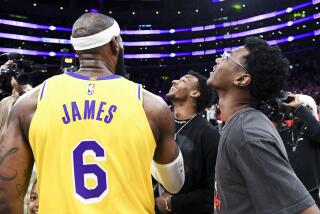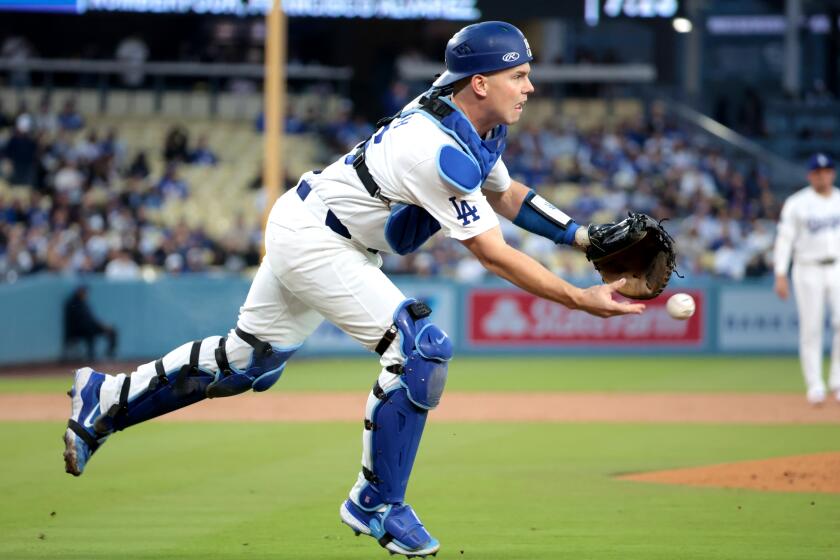Conte Gets Prison Term
Victor Conte, the self-described nutritionist at the center of the far-reaching BALCO doping scandal, was sentenced Tuesday in San Francisco federal court to eight months of confinement as part of a plea bargain struck with prosecutors.
Conte, 55, of San Mateo, who entered guilty pleas in July to one count of conspiracy to distribute steroids and a second count of laundering a portion of a check, will spend four months in prison and another four under house arrest. He was also fined $10,000.
U.S. Attorney Kevin Ryan said he hoped those “engaged in the use of steroids or performance-enhancing drugs are taking a look at what happened today.” He also asserted in a conference call that the case had “galvanized a debate” nationwide about the use of performance-enhancing drugs in professional and Olympic sport.
The BALCO case erupted two years ago. Dozens of prominent athletes, among them baseball slugger Barry Bonds and gold-medal-winning track star Marion Jones, were revealed to have ties to Conte or to his firm, the Burlingame, Calif.-based Bay Area Laboratory Cooperative.
A designer steroid, THG, discovered in the course of the BALCO investigation, is now banned. Congress, which in a number of hearings has sought to explore the extent of illicit doping, is weighing a more strict and uniform approach in regulating performance-enhancing substances.
And the BALCO investigation seems far from over. The San Francisco Chronicle recently reported that federal agents last month searched the laboratory and home of an Illinois chemist, Patrick Arnold, named in an Internal Revenue Service report as the reputed source of the designer steroid THG, a liquid code-named “the clear.”
Arnold is also known as a source of the steroid precursor androstenedione, which St. Louis Cardinal slugger Mark McGwire said he used in breaking baseball’s single-season home run record in 1998. At the time, baseball had not banned the substance.
The case has illuminated the limits of court proceedings to effect change.
Conte said Tuesday that, “Even the so-called ‘gold standard’ anti-doping programs designed for Olympic-caliber athletes are ineffective, let alone the inept programs that exist in professional sports.”
He also pledged his assistance in establishing stronger testing programs and, specifically, “to explain exactly how elite athletes routinely beat the existing anti-doping programs.”
The BALCO case was announced in February 2004 to great fanfare, with then-U.S. Atty. John Ashcroft announcing a 42-count indictment against Conte and three others at a news conference in Washington.
No athletes were named in that indictment and no athletes have been charged.
“Typically, in drug distribution cases, end users are not targets,” Matt Parella, chief of the U.S. attorney’s San Jose branch, said in explaining why athletes have not been prosecuted.
Asked if authorities believe any of the athlete witnesses offered untruthful testimony, Ryan declined to comment.
Federal sentencing rules, now under review, treat steroids with leniency.
Greg Anderson, Bonds’ trainer, was sentenced to six months of confinement after pleading guilty to money laundering and a steroid distribution charge. Anderson, 39, of Burlingame, will spend three months behind bars, another three under house arrest.
James Valente, 50, of Redwood City, BALCO’s vice president, was sentenced to three years’ probation.
A fourth defendant, track coach Remi Korchemny, is expected to get probation at a later sentencing date.
Conte and Anderson remain free on bond. Each is due to surrender to authorities Dec. 1.
The BALCO court files in San Francisco contain a report that recounts IRS special agent Jeff Novitzky’s Sept. 3, 2003 interview with Conte in which Conte purportedly asserts that Bonds was, “one of the players that Anderson brought to Conte to obtain the clear and the cream.” Conte added, “Bonds takes ‘the clear’ and ‘the cream’ on a regular basis.”
“The cream” was code for another steroid.
Bonds, according to grand jury testimony obtained by the Chronicle, testified that he had received a cream and a clear substance from Anderson but thought he was using arthritis balm and flaxseed oil.
Congress has repeatedly in recent months questioned Major League Baseball’s doping policies.
At the most recent hearing in Washington, Sept. 28 before the Senate Commerce Committee, Commissioner Bud Selig said that if players did not consent to his proposal -- suspensions of 50 games for a first-time offense, 100 for a second, a lifetime ban for a third -- he would back legislative proposals that would impose a two-year suspension for a first violation, a lifetime ban for a second.
The two-year rule is consistent with the World Anti-Doping Code, the protocol followed by Olympic sports.
Eleven major-league baseball players, including Baltimore Oriole star Rafael Palmeiro, have tested positive this year for steroids. New York Mets reliever Felix Heredia became the latest on Tuesday. His suspension will run for the first 10 days of the 2006 season.
Also Tuesday, the Washington Post reported that it had purchased five dietary supplements online -- and found after testing conducted at the Olympic-accredited UCLA lab that four contained previously undetected steroids.
According to the Post, the Montreal-based World Anti-Doping Agency announced last month that it planned to place the steroids in three of the products obtained by the newspaper on its 2006 list of banned drugs. The newspaper said that decision was not connected to the testing done at UCLA of the five supplements.
In 2003, an International Olympic Committee study -- which tested 634 supplements bought in 13 countries -- found that 14.8% were contaminated with substances not included on the product’s label that would have produced a positive doping test.
Anti-doping experts say steroids remain conveniently available for those in the know, easier still with the advent of the Internet, and that more designer steroids are easy to produce by adjusting the molecular structure of known drugs.
Gary Wadler, a Long Island physician, professor at New York University Medical School and one of the nation’s leading anti-doping experts, said of designing a new steroid, “An expression I often hear is, ‘This is not rocket science.’
“If you have any modicum of comfort with organic chemistry,” he said, changing a compound with the aim of making itundetectable by testers is “not that difficult.”
More to Read
Get our high school sports newsletter
Prep Rally is devoted to the SoCal high school sports experience, bringing you scores, stories and a behind-the-scenes look at what makes prep sports so popular.
You may occasionally receive promotional content from the Los Angeles Times.






